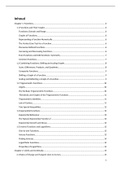Samenvatting
Summary Thomas' Calculus Early Transcendentals 14th edition
- Instelling
- Universiteit Utrecht (UU)
- Boek
- Thomas\' Calculus
Mathematics summary of the chapters 1-4 , chapter 5.5 and 5.6, chapter 7.1, chapter 8.1 - 8.4 from Thomas' Calculus Early Transcendentals 14th edition.
[Meer zien]





